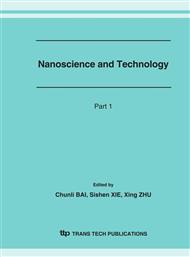[1]
C. Joachim, J.K. Gimzewski, and A. Aviram, Nature 408, 541-548, (2000).
Google Scholar
[2]
H.W. Kroto, J .R. Heath, and S.C. O'Brien, at el, Nature 318, 162-163 (1985).
Google Scholar
[3]
W. Kratschmer, L. Lamb, K. Fostiropoulos and D. Huffman, Nature 347, 354-358 (1990).
Google Scholar
[4]
S. Saito and A. Oshiyama, Phys. Rev. Lett. 66, 2637-2640 (1991).
Google Scholar
[5]
C. Joachim, J.K. Gimzewski, R.R. Schlittler, and C. Chavy, Phys. Rev. Lett. 74, 2102 -2105 (1995).
Google Scholar
[6]
M. Paulsson and S. Stafstrom, J. Phys. Condensed Matter 11, 3555-3562 (1999).
Google Scholar
[7]
S. Nakanishi and M Tsukada, Phys. Rev. Lett. 87, 126801 (2001).
Google Scholar
[8]
O. Gunnarsson and J.E. Han, Nature 405, 1027-1029 (2000).
Google Scholar
[9]
J.E. Han and O. Gunnarsson, Phys. Rev. B 61, 8628-8630 (2000).
Google Scholar
[10]
E. Koch and O. Gunnarsson, Phys. Rev. B 67, 161402(R)-161405 (2003).
Google Scholar
[11]
R.E. Dinnebier, et al, Science 296 , 109-111 (2002).
Google Scholar
[12]
E. Koch and O. Gunnarsson, Physica A 280, 166-178 (2000).
Google Scholar
[13]
O. Gunnarsson, Nature 408, 528-530 (2000).
Google Scholar
[14]
E. Koch and O. Gunnarsson, Phys. Rev. B 67, 161402(R) (2003).
Google Scholar
[15]
D.W. Boukhvalov, P.F. Karimov and E.Z. Kurmaev at el, Phys. Rev. B 69, 115425-9 (2004).
Google Scholar
[16]
M.S. Fuhrer, J. Nygård, and L. Shih et al, Science 288, 494-497 (2000).
Google Scholar
[17]
H. Park, J. Park, A.K. L. Lim, E. H. Anderson, A. Paulalivsatos & P. L. Mceuen, Nature 407, 57-60 (2000).
Google Scholar
[18]
J. Park. et al, Nature 417, 722-725 (2002).
Google Scholar
[19]
B. W. Smith, M. Monthioux and D. E. Luzzi, Nature, 323-324 (1998).
Google Scholar
[20]
G.K. Gueorguiev, J.M. Pacheco and D. Tomanek, Quantum effects in the polarizability of carbon Fullerenes Phys. Rev. Lett 92, 215501, (2004).
Google Scholar
[21]
D.W. Boukhvalov, P.F. Karimov and E.Z. Kurmaev at el, Phys. Rev. B 69, 115425-9 (2004).
Google Scholar
[22]
R. Yamachika, M. Grobis, A. Wachowiak, and M. F. Crommie, Science 304, 281-284 (2004).
DOI: 10.1126/science.1095069
Google Scholar
[23]
R Kato, Electron transport in molecules, (Tokyo; Iwanami) 1-50 (2001).
Google Scholar
[24]
R. Landauer, Phys. Lett., 85A, 91-93 (1981).
Google Scholar
[25]
M. Büttiker, Y. Imry and R. Landauer et al, Phys. Rev. B 31, 6207-6215 (1985).
Google Scholar
[26]
R. Landauer, Z. Phys. B68, 217 (1987).
Google Scholar
[27]
M. Büttiker, IBM J. Res. Dev. 32, 63 (1988).
Google Scholar
[28]
L. Wang, K. Tagami and M. Tsukada, Jpn. J. App. Phys. 43, 2779 (2004).
Google Scholar
[29]
S. Nakanishi and M. Tsukada, Surf. Sci. 438, 305 (1999).
Google Scholar
[30]
K. Tagami and M. Tsukada, J. Surf. Sci. Nanotech. 2, 205-209 ( 2004).
Google Scholar
[31]
K. Tagami, L. Wang and M. Tsukada, Nano letters 4, 209 (2004).
Google Scholar


